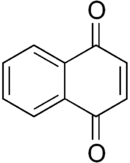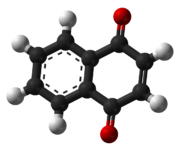- Naphthoquinone
-
Naphthoquinone[1] 
 4a,8a-Dihydronaphthalene-1,4-dioneOther namesNaphthoquinone
4a,8a-Dihydronaphthalene-1,4-dioneOther namesNaphthoquinone
1,4-Naphthoquinone
α-NaphthoquinoneIdentifiers CAS number 130-15-4 
ChEMBL CHEMBL55934 
Jmol-3D images Image 1 - O=C2C=CC(C1=CC=CC=C12)=O
Properties Molecular formula C10H6O2 Molar mass 158.15 g/mol Density 1.422 g/cm³ Melting point 126 °C
Boiling point Begins to sublime at 100 °C
Solubility in water 0.09 g/L  (verify) (what is:
(verify) (what is:  /
/ ?)
?)
Except where noted otherwise, data are given for materials in their standard state (at 25 °C, 100 kPa)Infobox references Naphthoquinone is a class of natural phenols based on the C6-C4 skeleton.
1,4-Naphthoquinone can be viewed as derivatives of naphthalene through the replacement of two hydrogen atoms by two ketone groups.
The name is also used generically for two other isomers:
- 1,2-Naphthoquinone
- 1,4-Naphthoquinone
- 2,6-Naphthoquinone (amphi-naphthoquinone)
Naturally occurring naphtoquinones
Contents
Properties
1,4-Naphthoquinone forms yellow triclinic crystals and has an odor similar to benzoquinone. It is sparingly soluble in cold water, slightly soluble in petroleum ether, and freely soluble in most polar organic solvents. In alkaline solutions it produces a reddish-brown color. Because of their aromatic stability, 1,4-naphthoquinone derivatives are known to possess anti-bacterial and anti-tumor properties.
Naphthoquinone forms the central chemical structure of many natural compounds, most notably the K vitamins.
Medicinal uses
Naphthoquinone derivatives have significant pharmacological properties. They are cytotoxic, they have significant antibacterial, antifungal, antiviral, insecticidal, anti-inflammatory, and antipyretic properties. Plants with naphthoquinone content are widely used in China and the countries of South America, where they are used to treat malignant and parasitic diseases.[2]
See also
- Hydroxynaphthoquinone
- 1,4-Benzoquinone
- Plumbagin
- Quinone
References
- ^ Merck Index, 11th Edition, 6315.
- ^ Babula, P; Adam, V; Havel, L; Kizek, R (2007). "Naphthoquinones and their pharmacological properties". Ceska a Slovenska farmacie : casopis Ceske farmaceuticke spolecnosti a Slovenske farmaceuticke spolecnosti 56 (3): 114–20. PMID 17867522.
Vitamins (A11) Fat soluble D2 (Ergosterol, Ergocalciferol#) · D3 (7-Dehydrocholesterol, Previtamin D3, Cholecalciferol, 25-hydroxycholecalciferol, Calcitriol (1,25-dihydroxycholecalciferol), Calcitroic acid) · D4 (Dihydroergocalciferol) · D5 · D analogues (Dihydrotachysterol, Calcipotriol, Tacalcitol, Paricalcitol)Water soluble B1 (Thiamine#) · B2 (Riboflavin#) · B3 (Niacin, Nicotinamide#) · B5 (Pantothenic acid, Dexpanthenol, Pantethine) · B6 (Pyridoxine#, Pyridoxal phosphate, Pyridoxamine) · B7 (Biotin) · B9 (Folic acid, Dihydrofolic acid, Folinic acid) · B12 (Cyanocobalamin, Hydroxocobalamin, Methylcobalamin, Cobamamide) · CholineCombinations M: NUT
cof, enz, met
noco, nuvi, sysi/epon, met
drug(A8/11/12)
Classes Anthraquinones | chalconoids (C6-C3-C6) | Curcuminoids | Kavalactones | Naphthoquinones (C6-C4) | Phenylpropanoids (C6-C3) | Xanthonoids | IsocoumarinsSee also: Categories:- Naphthoquinones
Wikimedia Foundation. 2010.
